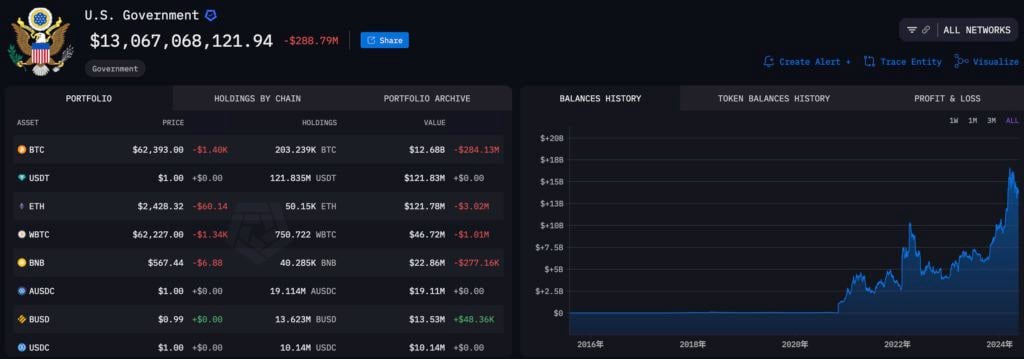After a brief rebound in the first half of the year, mainstream cryptocurrency prices entered a period of adjustment starting in October, and further declined in November. Currently, with the end of the US government shutdown, official liquidity is expected to return. What will the cryptocurrency market look like in the last two months of 2025?
![图片[1]-With global liquidity structurally diverging, why has the cryptocurrency market become the laggard?-OzABC](https://www.ozabc.com/wp-content/uploads/Bitcoin-Down-1140x570-1-800x400.jpeg)
Since mid-2025, the cryptocurrency market has experienced high volatility and downward pressure, with major asset prices continuing to decline, trading volumes shrinking, and investor confidence declining. The total market capitalization of cryptocurrencies is approximately $3.33 trillion, a decrease of about 20-30% from its peak at the beginning of the year. Bitcoin’s dominance has remained stable at around 55%, with volatility reaching as high as 40%, far exceeding that of 2024. Market sentiment is cautious.
CryptoQuant’s on-chain data shows that Bitcoin reserves on exchanges have fallen by about 8% since early August, with the value of reserves in USD dropping from approximately 300 billion to 250 billion in November. This indicates that investors are withdrawing funds from exchanges (moving towards self-custody or safe-haven assets), reinforcing the sell-off signal.
After a brief rebound in the first half of 2025, mainstream cryptocurrency prices entered a period of adjustment starting in October, and further declined in November, with the prices of the Top 50 cryptocurrencies almost falling back to the levels seen after the FTX crash in 2022.
To summarize the current state of the cryptocurrency market in 2025, this includes:
- Major cryptocurrencies such as SOL, Ethereum, and Bitcoin have returned to their December 2024 prices; the four-year cycle theory has failed, and industry participants need to adjust and adapt.
- Token supply explosion: Over the past four years, most token issuance models have been low circulation and high FDV (Funds-to-Volume). Following the Meme craze, the number has increased rapidly; currently, new projects are launching daily, resulting in a massive supply in the market. Capital is becoming increasingly cautious, and unless new buyers continuously flood in, it will be insufficient to offset the large-scale unlocking of tokens.
- The market has entered a period of overuse of concepts: insufficient innovation; a large number of non-essential technologies exist.
- Project implementation faces difficulties: the economic model’s incentive and adjustment effects are ineffective; many projects have failed to find product-market fit (PMF).
- Airdrop weakness: Airdropped tokens were immediately exchanged for stablecoins by users;
- Trading difficulty has increased significantly: competition will be extremely fierce for any worthwhile and liquid asset.
- Tight cash flow: VC investment has shrunk, with total financing accounting for only about half of that in 2024, leaving project owners with tight cash flow.
- The industry is plagued by internal problems: the October 11 “black swan” event; frequent hacker attacks (losses exceeding $2 billion in the first half of the year); Layer 1 chain congestion, etc.
- DeFi yields have decreased: Compared to 2024, DeFi yields have fallen below 5%.
This is more like a structural adjustment, similar to 2018, but on a larger scale. It has created difficulties for almost every market participant, whether they are users, traders, meme enthusiasts, entrepreneurs, VCs, quantitative firms, or others.
Especially after Black Friday, October 11, many cryptocurrency traders and quantitative firms suffered losses, and concerns about institutional collapse remain. This event means that speculators, professional traders, and retail investors all face financial losses.
Traditional financial institutions’ involvement is concentrated in areas such as Bitcoin and payments, RWA, and DAT strategies, which are relatively isolated from the altcoin market. Bitcoin spot ETFs performed strongly overall in October, with net inflows of $3.4 billion, setting a historical record. However, a large-scale outflow of funds occurred in early November, reflecting to some extent profit-taking behavior in the market at high prices.
With the US government shutdown now over, official liquidity is expected to return. What will the cryptocurrency market look like in the last two months of 2025?
The increasingly clear direction remains: Bitcoin and stablecoins.
BTC: Macro liquidity cycle replaces halving narrative
As market consensus gradually shifts, analysts believe that the global liquidity cycle, rather than simply the Bitcoin halving event, is the core driver of the bull-bear market transition.
Based on Arthur Hayes’ recent core argument that “the four-year cycle is dead, the liquidity cycle is immortal,” he believes that the past three bull and bear markets have closely coincided with periods of large-scale balance sheet expansion in the USD/CNY exchange rate and low-interest-rate credit easing. Currently, US Treasury bonds are piling up exponentially, and to dilute debt, the Standing Repurchase Facility (SRF) will become the government’s primary tool; the growth of the SRF balance implies a synchronized expansion of the global fiat currency supply. Under this “implicit quantitative easing,” the upward trend of Bitcoin will not change.
It is believed that the Standing Repo Facility (SRF) will become a primary tool for governments. Given the current stable money market conditions and the exponential growth in government debt, the SRF balance will continue to rise as a lender of last resort. The growth of the SRF balance implies a synchronized expansion of the global fiat currency supply, which will reignite the Bitcoin bull market.
Raoul Pal’s cycle theory also points out that the end of each cryptocurrency cycle stems from monetary tightening policies. Data shows that global debt has reached approximately $300 trillion, of which about $10 trillion (mainly US Treasury and corporate bonds) is about to mature. To prevent yields from soaring, a large-scale injection of liquidity is needed. According to his model estimates, every additional $1 trillion in liquidity may be associated with a 5-10% increase in returns on risky assets (stocks, cryptocurrencies). A $10 trillion refinancing scale could inject $2-3 trillion in new funds into risky assets, thereby strongly driving up Bitcoin’s price.
All of these ideas, under the dominance of global central bank liquidity cycles, provide a macroeconomic environment for the long-term rise of scarce assets such as Bitcoin.
Stablecoins: Towards Financial Infrastructure
Another key theme in 2025 is stablecoins, whose value lies not in “speculative narratives” but in “real adoption”.
The latest favorable policy has been released: the US Congress is pushing to grant the CFTC (Commodity Futures Trading Commission) greater jurisdiction over the cryptocurrency spot market. The CFTC is expected to introduce a policy early next year that could allow stablecoins to be used as tokenized collateral in the derivatives market. This will first be piloted in US clearinghouses and accompanied by stricter regulations, opening the door for stablecoins to enter the core of traditional finance.
The stablecoin market is expanding rapidly, far exceeding market expectations. Major U.S. institutions have already taken the lead in deploying resources to build a new payment network centered around stablecoins.
Faced with the explosion of real-world applications, the value of stablecoins lies in their ability to “perform steadily” in scenarios such as cross-border transfers, exchange rate risk control, and corporate settlement and allocation.
Over the past year, it has struck a balance between speed, cost, and compliance, initially establishing a compliant, low-cost, and traceable global funding channel, and is gradually becoming a usable financial settlement layer in the real world. As infrastructure, stablecoins are solidifying their position through regulation and practical applications, providing stable lifeblood to the entire crypto economy.
This also offers insights for entrepreneurs: startup teams need to consider “stablecoin nativeizing” their business processes, target the “stablecoin-adapted population” in their target market, and find a truly fitting product-market fit (PMF) based on that.

















